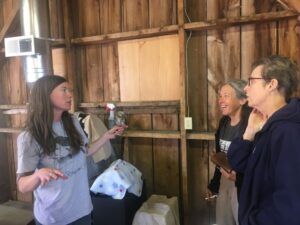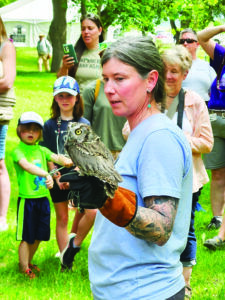
by John Dowd
Last Sunday was Raptor Day at the Daly Mansion. The event brought several organizations together to speak on predatory birds, chiefly Wild Skies Raptor Center, out of Potomac. According to center founder and executive director, Brooke Tanner, they actually get around 40% of their birds from the Bitterroot area, even though they cover a vast area that stretches from as far north as the Mission Valley and Great Falls, west to the Idaho border, south past Philipsburg and over all of the Bitterroot Valley. With such a large percentage originating from the area, it was decided that providing some public education may be a good idea.
The center takes in falcons, hawks, owls, eagles and even vultures and works to treat, rehabilitate and eventually release all of the birds they rescue. However, according to Tanner, the reality is that they are only able to release about 50% to 60% of their rescues. Of course, “our goal is to release them and get them back where they are from,” but this does not always happen, said Tanner.

The event was not only to spread awareness of the raptor center, but to collect donations for the center. According to event organizer, Dorreen Romans, the event was meant to help support “this deserving 501c3 that takes in all injured raptors. They had a difficult winter with pipes that burst, medicines that were destroyed and among many other issues, having to bring in the injured birds into their home because of the 30 below temperatures at their facility!”
Wild Skies Raptor Center has taken in many birds from the Daly Mansion property in the past. This made it the perfect location to speak about the birds they are trying to rescue, and to bring along several avian ambassadors. In the end, Raptor Day drew over 300 people.
For Tanner, this is an important time to do this outreach because the spring and summer can often be popular seasons for raptors in need of rescue.
During the event, Tanner spoke on the process the birds go through, from rescue to release. She spoke about recovery, explaining that the birds will often need surgery. After that, birds will receive physical rehabilitation, attempting to get them back in shape for a return to the wild. Released birds are also given unique bands, allowing them to be tracked upon future recoveries. These bands have contact information for anyone who finds a bird, allowing them to report the raptor, helping researchers identify causes of death and even bird age. According to Tanner, this has allowed raptor researchers to learn that some eagles can live well over 30 years.

Some of these birds cannot be released, and this will necessitate either rehoming or, in many cases, euthanization. This is especially true for owls and red tailed hawks, as these birds are common and hard to rehome into educational facilities. In the case of eagles, which are making a comeback, this can also now be difficult. For these federally protected birds, there are specific federal limitations that further challenge their release and rehoming. In cases where, for example, they are one-legged, they cannot be released and must be rehomed in an educational space, otherwise they will need to be euthanized.
Tanner has been rehabbing birds for 18 years, and started her own rescue, Wild Skies Raptor Center, in 2010. “I started off just trying to help out wildlife when I was younger,” said Tanner. She started off primarily in the rehabilitation side, with a veterinary technician degree. However, she eventually discovered the need for public education on the plights that raptors face. “It’s just something really important to try and save these birds,” she said, noting that the majority of these crises are “anthropomorphic.” Tanner believes she, and others, have a “moral obligation because these birds are getting injured due to human causes.”
The center’s education events, like this one, cover many of the challenges raptors face, making people aware of how their actions can indirectly affect these birds’ lives. From car strikes and birds on the sides of roads, to lead poisoning from eating carcasses that have not been cleaned or discarded properly, raptors can have a difficult time.
Tanner also mentioned baling twine is a common threat, especially in rural areas. Raptors will often utilize twine, or fishing line, in the construction of nests. These will not deteriorate well over time, and can strangle or trap chicks, increasing their already high mortality rate. According to Tanner, in a recent study around 5% to 10% of osprey chicks in Montana were lost due to issues with baling twine.
Raptors that specifically hunt vermin face another danger. In many rural areas, rodenticides are used, and birds that consume these mice, rats and squirrels that have been poisoned can often be poisoned as well.
However, according to Tanner, not all injuries and health concerns that are human-related stem from accidents. “Raptors get a hard rap,” according to Tanner, because they are predators. Because of this, many residents can often find their livestock threatened, especially chickens. Because of the feed given to these animals, often rodents are drawn in. This will also bring in hungry birds. Tanner said it is not uncommon to find birds that have been shot, including federally protected birds. In fact, the Bitterroot is a big offender in this department. According to Tanner, in the last 11 years they have received around 45 birds that have either died or become injured from being shot. Of that, 27 have come from the Bitterroot Valley.
Tanner said this can be devastating, as shooting one bird will in turn affect their entire family. Many of these raptors require two parents to hunt enough to feed their chicks.
Tanner said this can be a real shame, as raptors can be extremely beneficial to the environment, from vultures that take care of dead carcasses, to falcons, owls and eagles that will hunt various pests. These species are also considered “bio-indicators,” meaning that their healthy populations will often imply that the rest of the populations, down the food chain, may also be healthy.
Anyone who discovers an injured raptor is encouraged to call (406) 210-3468. According to Tanner, the center is always on call. “We don’t take any days off,” she said, but they may not answer late at night. “We’re pretty good, especially during daylight hours,” about responding quickly, said Tanner. The center is also linked up with various other wildlife organizations, such as Montana Fish, Wildlife and Parks, the Forest Service, various veterinary clinics and other rescues. These groups will help finders connect with the center.
